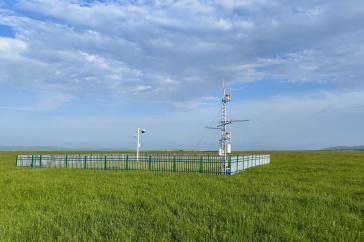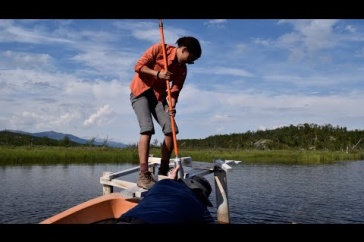
Joe Souney inspects an ice core drilled from a previous project in Antarctica. Photo credit: Kendrick Taylor
What does it take to drill ice cores for climate research in one of the most inhospitable locations on the planet? Scientists from the UNH Earth Systems Research Center have received a five-year, $425,000 grant from the National Science Foundation’s Office of Polar Programs to plan the logistics of retrieving environmental samples in ice that could unlock the secrets of Earth’s last warm period — and possibly help inform future climate change projections.
UNH Research project managers Joe Souney and Mark Twickler will produce a comprehensive set of logistical plans and coordinate multiple ice core science projects led by other scientists while on Antarctica’s Hercules Dome — a remote region devoid of any established buildings or camps, hundreds of miles from McMurdo Station and the South Pole Station.

When snow falls in Antarctica’s interior, it rarely melts, and instead builds up in thick annual layers, which are compressed into ice by subsequent snowfall. The ice layers contain dissolved chemicals, insoluble dust particles, and atmospheric gases that were present when the snow fell. “By drilling down into the ice sheet and recovering these cylinders of ice from ancient times, it allows us to look back in time for thousands and thousands of years and determine what the climate conditions were like back then,” Souney explains.
“The ice cores from this region should provide the most detailed Eemian epoch environmental record available pretty much anywhere in the world,” Twickler says. “The Eemian epoch, which was about 120,000 – 130,000 years ago, was the last time the Earth was in a warm period like our current Holocene. If we can better understand the environmental drivers during the Eemian epoch, it will help us better understand our current climatic conditions and help predict future conditions.”
In the first two years of the grant, Souney and Twickler will work with the NSF Antarctic support contractor to plan for the field work and make sure it can be supported with the available logistics. It's this kind of behind-the-scenes planning that’s crucial to ensure the project can move forward as planned and go as smoothly as possible.
“Our planning will detail, for example, how we will get ourselves and all of the required science cargo and camp materials to Hercules Dome, likely through a combination of overland traverse and aircraft support; specifics on the field camp, such as camp population, camp structures and layout, power and fuel requirements, camp equipment; and the fieldwork schedule,” Souney explains. Provided all those logistics can be worked out, the last three years of the grant will entail the actual ice core drilling, with Souney on site helping to coordinate the numerous scientific teams involved in the field work."The ice cores from this region should provide the most detailed Eemian epoch environmental record available pretty much anywhere in the world."
The site itself is approximately 8,200 feet above sea level with a mean average temperature of -35 degrees Fahrenheit, so it will be a cold location at which to work.
“Once we get the camp established, we will be onsite at Hercules Dome for two or three months during each field season and everyone will be sleeping in tents, so the physical working and living conditions there will be challenging,” Souney adds.
Although Souney and Twickler will not be involved in analyzing the ice cores, they will collaborate with the NSF Ice Core Facility (NSF-ICF) in Lakewood, Colorado, where the samples will be transported and stored, on the planning and organization for the sampling of the ice. After each field season of drilling, scientists and students will gather at the NSF-ICF to split the cores into sections and cut samples from the ice according to an agreed-upon cut plan so that every lab has what it needs to conduct its analyses on the ice.
Despite the seeming enormity of these tasks, researchers at UNH, including Souney and Twickler, have a lot of prior experience planning large community-based ice core drilling projects. Both researchers were involved in the planning and science coordination for the NSF-funded West Antarctic Ice Sheet Divide (WAIS) ice core project, which recovered the longest U.S. ice core to date from the polar regions; more than two miles of cores provided scientists with details on the environmental conditions during the last 68,000 years. More recently, the two took part in the NSF-funded South Pole ice core project, which provided records of the climate history of a unique area of East Antarctica during the last 54,000 years, Souney explains.
“We’re excited to take the planning and logistics lessons we learned during the WAIS Divide and South Pole ice core projects and apply them to this new and challenging site at Hercules Dome,” he adds.
The Institute for the Study of Earth, Oceans, and Space (EOS) is UNH's largest research enterprise, comprising six centers with a focus on interdisciplinary, high-impact research on Earth and climate systems, space science, the marine environment, seafloor mapping, and environmental acoustics. With more than $60 million in external funding secured annually, EOS fosters an intellectual and scientific environment that advances visionary scholarship and leadership in world-class research and graduate education.
-
Written By:
Rebecca Irelan | Institute for the Study of Earth, Oceans, and Space | rebecca.irelan@unh.edu | 603-862-0990



















































